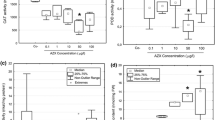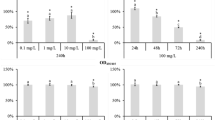Abstract
Azoxystrobin is a strobilurin of growing concern in aquatic environments because it is the most sold fungicide worldwide, however, the information available about its effect on aquatic non-target organisms is scarce. The objective of the present study was to evaluate potential physiological, biochemical, and genetic effects at environmentally relevant (1–10 μg/L) and elevated (100–500 μg/L) concentrations in the aquatic macrophyte Myriophyllum quitense exposed to the commercial formulation AMISTAR®. Following an acute 24-h exposure, there were no effects of AMISTAR® on photosynthetic pigments at any of the concentrations evaluated. Glutathione-S-transferase activity was significantly elevated at 1 and 10 μg/L AZX. Significant decrease of catalase and guaiacol peroxidase activities in plants exposed to 500 μg/L, and to 100 and 500 μg/L, respectively, and an increase in glycolate oxidase activity at 500 μg/L was observed. DNA damage at 100 and 500 μg/L was observed. These data indicate that although environmentally relevant levels of AMISTAR® did not result cytotoxic, this fungicide was genotoxic, affecting the physiological process of photorespiration and caused oxidative damage at high concentrations. In this sense, it is necessary to explore sub-lethal responses in non-target organisms because some effects could promote further potential long-term biological consequences in a context of repeated pulses of exposure.



Similar content being viewed by others
References
Anderson MJ, Robinson J (2003) Generalized discriminant analysis based on distances. Aust N Z J Stat 45:301–318
Anderson MJ, Willis TJ (2003) Canonical analysis of principal coordinates: a useful method of constrained ordination for ecology. Ecology 84:511–525
Archer EK, Ting BL (1996) A virescent plastid mutation in tobacco decreases peroxisome enzyme activities in seedlings. J Plant Physiol 149:520–526
Arts G, Davies J, Dobbs M, Ebke P, Hanson M, Hommen U, Knauer K, Loutseti S, Maltby L, Mohr S, Poovey A, Poulsen V (2010) AMEG: the new SETAC advisory group on aquatic macrophyte ecotoxicology. Environ Sci Pollut Res 17:820–823
Balba H (2007) Review of strobilurin fungicide chemicals. J Environ Sci Health, Part B 42:441–451
Bartlett DW, Clough JM, Godfrey CR, Godwin JR, Hall AA, Heaney SP, Maund SJ (2001) Understanding the strobilurin fungicides. Pestic Outlook 12:143–148
Bartlett DW, Clough JM, Godwin JR, Hall AA, Hamer M, Parr-Dobrzanski B (2002) The strobilurin fungicides. Pest Manag Sci 58:649–662
Battaglin WA, Sandstrom MW, Kuivila KM, Kolpin DW, Meyer MT (2011) Occurrence of Azoxystrobin, Propiconazole, and selected other fungicides in US streams, 2005–2006. Water Air Soil Pollut 218:307–322
Berenzen N, Lentzen-Godding A, Probst M, Schulz H, Schulz R, Liess M (2005) A comparison of predicted and measured levels of runoff-related pesticide concentrations in small lowland streams on a landscape level. Chemosphere 58:683–691
Bickham JW, Sandhu S, Hebert PDN, Chikhi L, Athwal R (2000) Effects of chemical contaminants on genetic diversity in natural populations: implications for biomonitoring and ecotoxicology. Mutat Res 463:33–51
Boudina A, Emmelin C, Baaliouamer A, Paissé O, Chovelon JM (2007) Photochemical transformation of azoxystrobin in aqueous solutions. Chemosphere 68:1280–1288
Bradford MM (1976) A rapid and sensitive method for the quantitation of microgram quantities of protein utilizing the principle of protein-dye binding. Anal Biochem 72:248–254
Brain RA, Cedergreen N (2009) Biomarkers in aquatic plants: selection and utility. Rev Environ Contam Toxicol 198:49–109
Cao F, Zhu L, Li H, Yu S, Wang C, Qiu L (2016) Reproductive toxicity of azoxystrobin to adult zebrafish (Danio rerio). Environ Pollut 219:1109–1121
Claiborne A (1985) Catalase activity. In: Greenwald RA (ed) CRC handbook of methods in oxygen radical research. CRC Press, Boca Raton
Cole DJ (1994) Detoxification and activation of agrochemicals in plants. Pest Manag Sci 42:209–222
Cooke MS, Evans MD, Dizdaroglu M, Lunec J (2003) Oxidative DNA damage: mechanisms, mutation, and disease. FASEB J 17:1195–1214
Cummins I, Cole DJ, Edwards R (1999) A role for glutathione transferases functioning as glutathione peroxidases in resistance to multiple herbicides in black grass. The Plant J 18:285–292
De Gerónimo E, Aparicio VC, Bárbaro S, Portocarrero R, Jaime S, Costa JL (2014) Presence of pesticides in surface water from four sub-basins in Argentina. Chemosphere 107:423–431
Deb D, Engel BA, Harbor J, Hahn L, Jae Lim K, Zhai T (2010) Investigating potential water quality impacts of fungicides used to combat soybean rust in Indiana. Water Air Soil Pollut 207:273–288
Drotar A, Phelps P, Fall R (1985) Evidence for glutathione peroxidase activities in cultured plant cells. Plant Sci 42:35–40
Edwards PG, Murphy TM, Lydy MJ (2016) Fate and transport of agriculturally applied fungicidal compounds, azoxystrobin and propiconazole. Chemosphere 146:450–457
Garanzini DS, Menone ML (2015) Azoxystrobin causes oxidative stress and DNA damage in the aquatic macrophyte Myriophyllum quitense. Bull Environ Contam Toxicol 94:146–151
Ghosh RK, Singh N (2009) Effect of organic manure on sorption and degradation of azoxystrobin in soil. Eff Org Manure Sorpt Degrad Azoxystrobin Soil 57:632–636
Gustafsson K, Blidberg E, Karlsson Elfgren I, Hellstrom A, Kylin H, Gorokhova E (2010) Direct and indirect effects of the fungicide azoxystrobin in outdoor brackish water microcosms. Ecotoxicology 19:431–444
Habig WH, Pabst MJ, Jakoby WB (1974) Glutathione S-transferases the first enzymatic step in mercapturic acid formation. J Biol Chem 249:7130–7139
Han Y, Zhu L, Wang J, Wang J, Xie H, Zhang S (2014) Integrated assessment of oxidative stress and DNA damage in earthworms (Eisenia fetida) exposed to azoxystrobin. Ecotoxicol Environ Saf 107:214–219
Han Y, Liu T, Wang J, Wang J, Zhang C, Zhu L (2016) Genotoxicity and oxidative stress induced by the fungicide azoxystrobin in zebrafish (Danio rerio) livers. Pestic Biochem Physiol 133:13–19
Inskeep WP, Bloom PR (1985) Extinction coefficients of chlorophyll a and b in N, N-dimethylformamide and 80% acetone. Plant Physiol 77:483–485
Hocinat A, Boudemagh A (2016) Biodegradation of commercial Ortiva fungicide by isolated actinomycetes from the activated sludge. Desalin Water Treat 57:6091–6097
Huang X, Rogers RB, Orr N, Sparks TC, Gifford JM, Loso MR, Zhu Y, Meade T (2007) U.S. Patent Application No. 11/704,824
Jana S, Choudhuri MA (1982) Glycolate metabolism of three submersed aquatic angiosperms during ageing. Aquat Bot 12:345–354
Johansson M, Piha H, Kylin H, Merila H (2006) Toxicity of six pesticides to common frog (Rana temporaria) tadpoles. Environ Toxicol Chem 25:3164–3170
Kono Y, Fridovich I (1982) Superoxide radical inhibits catalase. J Biol Chem 257:5751–5754
Kozlowski LA, Simões DFM, Souza C (2009) Efeito fisiológico de estrobilurina F 500® no crescimento e rendimento do feijoeiro. Rev Acadêmica Ciênc Agrár E Ambient 7:41–54
Kunz JL, Ingersoll CG, Smalling KL, Elskus AA, Kuivila KM (2017) Chronic toxicity of azoxystrobin to freshwater amphipods, midges, cladocerans, and mussels in water- only exposures. Environ Toxicol Chem 36:2308–2315
Liang S, Xu X-W, Zhao X-F, Hou Z-G, Wang X-H, Lu Z-B (2016) Two new fatty acids esters were detected in ginseng stems by the application of azoxystrobin and the increasing of antioxidant enzyme activity and ginsenosides content. Pestic Biochem Physiol 134:63–72
Liu L, Jiang C, Wu Z-Q, Gong Y-X, Wang G-X (2013) Toxic effects of three strobilurins (trifloxystrobin, azoxystrobin and kresoxim-methyl) on mRNA expression and antioxidant enzymes in grass carp (Ctenopharyngodon idella) juveniles. Ecotoxicol Environ Saf 98:297–302
Liu L, Zhu B, Wang G-X (2015) Azoxystrobin-induced excessive reactive oxygen species (ROS) production and inhibition of photosynthesis in the unicellular green algae Chlorella vulgaris. Environ Sci Pollut Res 22:7766–7775
Lu T, Zhu Y, Xu J, Ke M, Zhang M, Tan C, Fu Z, Qian H (2018) Evaluation of the toxic response induced by azoxystrobin in the non-target green alga Chlorella pyrenoidosa. Environ Pollut 234:379–388
Marrs KA (1996) The functions and regulation of glutathione S-transferases in plants. Annu Rev Plant Biol 47:127–158
Martinez RS, Di Marzio WD, Sáenz ME (2015) Genotoxic effects of commercial formulations of Chlorpyrifos and Tebuconazole on green algae. Ecotoxicology 24:45–54
McCarthy I, Romero-Puertas MC, Palma JM, Sandalio LM, Corpas FJ, Gómez M, Del Rio LA (2001) Cadmium induces senescence symptoms in leaf peroxisomes of pea plants. Plant, Cell Environ 24:1065–1073
Menone ML, Pesce SF, Díaz MP, Moreno VJ, Wunderlin DA (2008) Endosulfan induces oxidative stress and changes on detoxication enzymes in the aquatic macrophyte Myriophyllum quitense. Phytochemistry 69:1150–1157
Nadin SB, Vargas-Roig LM, Ciocca DR (2001) A silver staining method for single-cell gel assay. J Histochem Cytochem 49:1183–1186
Nason MA, Farrar J, Bartlett D (2007) Strobilurin fungicides induce changes in photosynthetic gas exchange that do not improve water use efficiency of plants grown under conditions of water stress. Pest Manag Sci 63:1191–1200
Ngayila N, Botineau M, Baudu M, Basly J-P (2009) Myriophyllum alterniflorum DC. Effect of low concentrations of copper and cadmium on somatic and photosynthetic endpoints: a chemometric approach. Ecol Indic 9:307–312
Nimptsch J, Pflugmacher S (2007) Ammonia triggers the promotion of oxidative stress in the aquatic macrophyte Myriophyllum mattogrossense. Chemosphere 66:708–714
Nimptsch J, Wunderlin DA, Dollan A, Pflugmacher S (2005) Antioxidant and biotransformation enzymes in Myriophyllum quitense as biomarkers of heavy metal exposure and eutrophication in Suquía River basin (Córdoba, Argentina). Chemosphere 61:147–157
OECD 239 (2014) Test No. 239: water-sediment Myriophyllum Spicatum toxicity test
Olsvik PA, Kroglund F, Finstad B, Kristensen T (2010) Effects of the fungicide azoxystrobin on Atlantic salmon (Salmo salar L.) smolt. Ecotoxicol Environ Saf 73:1852–1861
Orchard AE (1981) A revision of South American Myriophyllum (Haloragaceae) and its repercussions on some Australian and North American species. Aust Syst Bot 4:27–65
Pereira JL, Antunes SC, Castro BB, Marques CR, Gonçalves AMM, Gonçalves F, Pereira R (2009) Toxicity evaluation of three pesticides on non-target aquatic and soil organisms: commercial formulation versus active ingredient. Ecotoxicology 18:455–463
Pflugmacher S (2004) Promotion of oxidative stress in the aquatic macrophyte Ceratophyllum demersum during biotransformation of the cyanobacterial toxin microcystin-LR. Aquat Toxicol 70:169–178
Poletta GL, Larriera A, Kleinsorge E, Mudry MD (2009) Genotoxicity of the herbicide formulation Roundup®(glyphosate) in broad-snouted caiman (Caiman latirostris) evidenced by the Comet assay and the Micronucleus test. Mutat Res 672:95–102
Popp J, Pet Ho K, Nagy J (2013) Pesticide productivity and food security. A review. Agron Sustain Dev 33:243–255
Reilly TJ, Smalling KL, Orlando JL, Kuivila KM (2012) Occurrence of boscalid and other selected fungicides in surface water and groundwater in three targeted use areas in the United States. Chemosphere 89:228–234
Rodrigues ET, Lopes I, Pardal MÂ (2013) Occurrence, fate and effects of azoxystrobin in aquatic ecosystems: a review. Environ Int 53:18–28
Rodrigues ET, Pardal MÂ, Gante C, Loureiro J, Lopes I (2017) Determination and validation of an aquatic Maximum Acceptable Concentration-Environmental Quality Standard (MAC-EQS) value for the agricultural fungicide azoxystrobin. Environ Pollut 221:150–158
Royal Society of Chemistry (n.d.) Organic chemistry contributing to food production [WWW Document], 2017. http://www.rsc.org/Membership/Networking/InterestGroups/OrganicDivision/organic-chemistry-case-studies/organic-chemistry-food-production.asp. Accessed 6.9.17
Shi Q, Zhu Z, Xu M, Qian Q, Yu J (2006) Effect of excess manganese on the antioxidant system in Cucumis sativus L. under two light intensities. Environ Exp Bot 58:197–205
Singh N, Singh SB, Mukerjee I, Gupta S, Gajbhiye VT, Sharma PK, Goel M, Dureja P (2010) Metabolism of 14C-azoxystrobin in water at different pH. J Environ Sci Health, Part B 45:123–127
Sohal RS, Mockett RJ, Orr WC (2002) Mechanisms of aging: an appraisal of the oxidative stress hypothesis. Free Radic Biol Med 33:575–586
SYNGENTA [WWW Document] (2017) https://www.sec.gov/Archives/edgar/data/1123661/000095010315001201/dp52748_20f.htm. Accessed 6.9.17
Valavanidis A, Vlahogianni T, Dassenakis M, Scoullos M (2006) Molecular biomarkers of oxidative stress in aquatic organisms in relation to toxic environmental pollutants. Ecotoxicol Environ Saf 64:178–189
Wu Y-X, von Tiedemann A (2001) Physiological effects of azoxystrobin and epoxiconazole on senescence and the oxidative status of wheat. Pest Biochem Physiol 71:1–10
Zar JH (1999) Biostatistical analysis. Pearson Education, London
Zhang Y-J, Zhang X, Chen C-J, Zhou M-G, Wang H-C (2010) Effects of fungicides JS399-19, Azoxystrobin, Tebuconazloe, and Carbendazim on the physiological and biochemical indices and grain yield of winter wheat. Pestic Biochem Physiol 98:151–157
Acknowledgements
This work was supported by FONCYT (PICT 2011 1597 and PICT 2013 1348) and UNMdP (EXA 795/16). This work is part of the Ph D. Thesis of D. Garanzini. We thanks very much Verónica Taglioretti and Gastón Iturburu for helping us with the statistical analysis of the data.
Author information
Authors and Affiliations
Corresponding author
Rights and permissions
About this article
Cite this article
Garanzini, D.S., Medici, S., Moreyra, L.D. et al. Acute exposure to a commercial formulation of Azoxystrobin alters antioxidant enzymes and elicit damage in the aquatic macrophyte Myriophyllum quitense. Physiol Mol Biol Plants 25, 135–143 (2019). https://doi.org/10.1007/s12298-018-0603-7
Received:
Revised:
Accepted:
Published:
Issue Date:
DOI: https://doi.org/10.1007/s12298-018-0603-7




